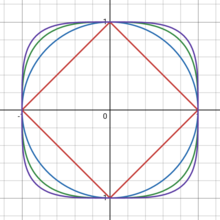Squigonometry or p-trigonometry is a branch of mathematics that extends traditional trigonometry to shapes other than circles, particularly to squircles, in the p-norm. Unlike trigonometry, which deals with the relationships between angles and side lengths of triangles and uses trigonometric functions, squigonometry focuses on analogous relationships within the context of a unit squircle.
Squigonometric functions are mostly used to solve certain indefinite integrals, using a method akin to trigonometric substitution.: This approach allows for the integration of functions that are otherwise computationally difficult to handle.
Squigonometry has been applied to find expressions for the volume of superellipsoids, such as the superegg.
Etymology
The term squigonometry is a portmanteau of squircle and trigonometry. The first use of the term "squigonometry" is undocumented: the coining of the word possibly emerged from mathematical curiosity and the need to solve problems involving squircle geometries. As mathematicians sought to generalize trigonometric ideas beyond circular shapes, they naturally extended these concepts to squircles, leading to the creation of new functions.
Nonetheless, it is well established that the idea of parametrizing curves that aren't perfect circles has been around for around 300 years. Over the span of three centuries, many mathematicians have thought about using functions similar to trigonometric functions to parameterize these generalized curves.
Squigonometric functions
Cosquine and squine
Definition through unit squircle

The cosquine and squine functions, denoted as and can be defined analogously to trigonometric functions on a unit circle, but instead using the coordinates of points on a unit squircle, described by the equation:
where is a real number greater than or equal to 1. Here corresponds to and corresponds to
Notably, when , the squigonometric functions coincide with the trigonometric functions.
Definition through differential equations
Similarly to how trigonometric functions are defined through differential equations, the cosquine and squine functions are also uniquely determined by solving the coupled initial value problem
Where corresponds to and corresponds to .
Definition through analysis
The definition of sine and cosine through integrals can be extended to define the squigonometric functions. Let and define a differentiable function by:
Since is strictly increasing it is a one-to-one function on with range , where is defined as follows:
Let be the inverse of on . This function can be extended to by defining the following relationship:
By this means is differentiable in and, corresponding to this, the function is defined by:
Tanquent, cotanquent, sequent and cosequent
The tanquent, cotanquent, sequent and cosequent functions can be defined as follows:
Inverse squigonometric functions
General versions of the inverse squine and cosquine can be derived from the initial value problem above. Let ; by the inverse function rule, . Solving for gives the definition of the inverse cosquine:
Similarly, the inverse squine is defined as:
Multiple ways to approach Squigonometry
Other parameterizations of squircles give rise to alternate definitions of these functions. For example, Edmunds, Lang, and Gurka define as:
.
Since is strictly increasing it has a =n inverse which, by analogy with the case , we denote by . This is defined on the interval , where is defined as follows:
.
Because of this, we know that is strictly increasing on , and . We extend to by defining:
for Similarly .
Thus is strictly decreasing on , and . Also:
.
This is immediate if , but it holds for all in view of symmetry and periodicity.
Applications
Solving integrals
Squigonometric substitution can be used to solve integrals, such as integrals in the generic form .
See also
References
- ^ Poodiack, Robert D. (April 2016). "Squigonometry, Hyperellipses, and Supereggs". Mathematics Magazine. 89 (2).
- Poodiack, Robert D.; Wood, William E. (2022). Squigonometry: The Study of Imperfect Circles (1st ed.). Springer Nature Switzerland. p. 1.
- Elbert, Á. (1987-09-01). "On the half-linear second order differential equations". Acta Mathematica Hungarica. 49 (3): 487–508. doi:10.1007/BF01951012. ISSN 1588-2632.
- Wood, William E. (October 2011). "Squigonometry". Mathematics Magazine. 84 (4): 264.
- Chebolu, Sunil; Hatfield, Andrew; Klette, Riley; Moore, Cristopher; Warden, Elizabeth (Fall 2022). "Trigonometric functions in the p-norm". BSU Undergraduate Mathematics Exchange. 16 (1): 4, 5.
- Girg, Petr E.; Kotrla, Lukáš (February 2014). Differentiability properties of p-trigonometric functions. p. 104.
- Edmunds, David E.; Gurka, Petr; Lang, Jan (2012). "Properties of generalized trigonometric functions". Journal of Approximation Theory. 164 (1): 49.
- Edmunds, David (2011). Eigenvalues, Embeddings and Generalised Trigonometric Functions. Springer-Verlag Berlin Heidelberg.
 and
and  can be defined analogously to trigonometric functions on a
can be defined analogously to trigonometric functions on a 
 is a
is a  corresponds to
corresponds to  corresponds to
corresponds to 
 , the squigonometric functions coincide with the trigonometric functions.
, the squigonometric functions coincide with the trigonometric functions.

 and define a
and define a  by:
by:

 is
is  with range
with range  , where
, where  is defined as follows:
is defined as follows:

 be the
be the  by defining the following relationship:
by defining the following relationship:

 and, corresponding to this, the function
and, corresponding to this, the function  is defined by:
is defined by:





 ; by the
; by the  . Solving for
. Solving for 

 as:
as:
 .
.
 . This is defined on the interval
. This is defined on the interval  is defined as follows:
is defined as follows:
 .
.
 ,
,  and
and  . We extend
. We extend  by defining:
by defining:
 for
for  Similarly
Similarly  .
.
 is
is  and
and  . Also:
. Also:
 .
.
 , but it holds for all
, but it holds for all  in view of symmetry and periodicity.
in view of symmetry and periodicity.
 .
.